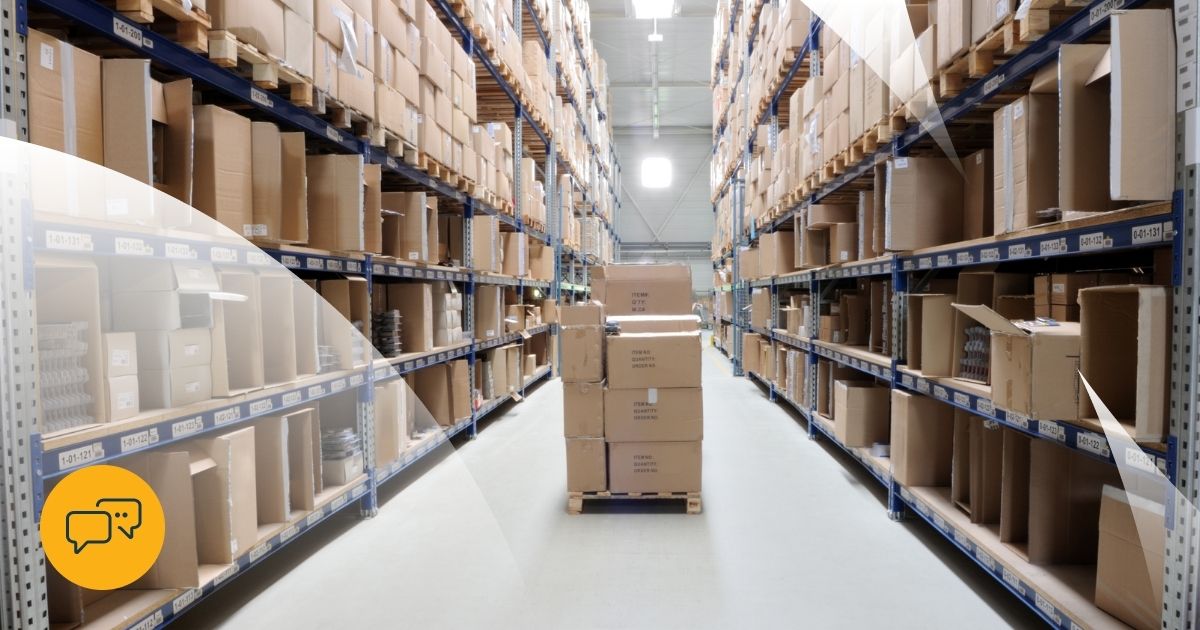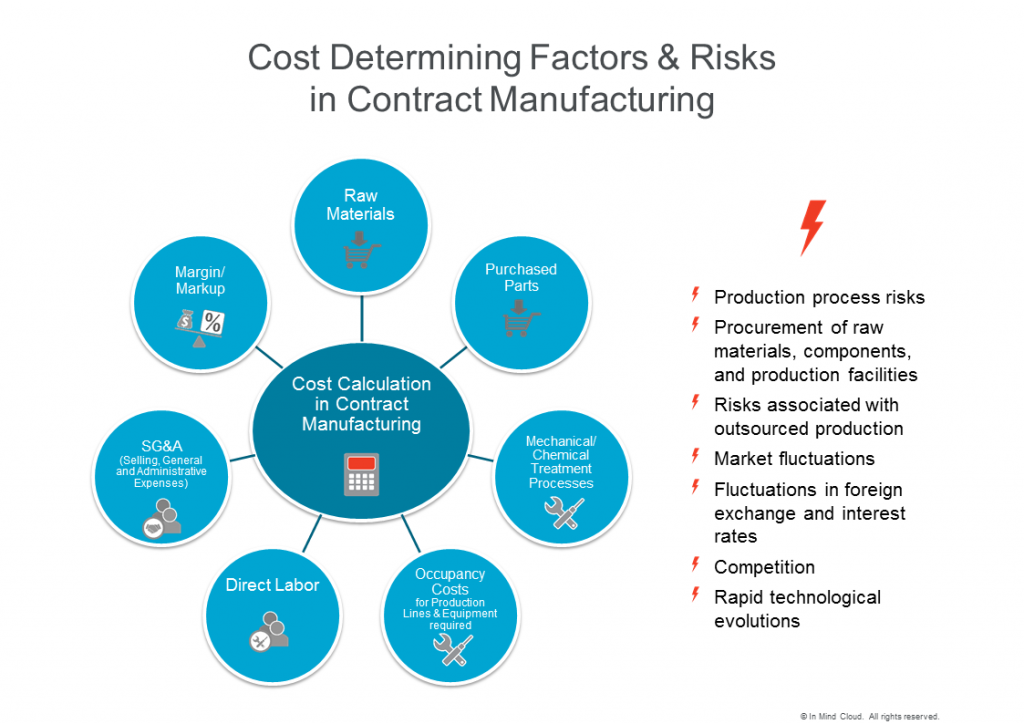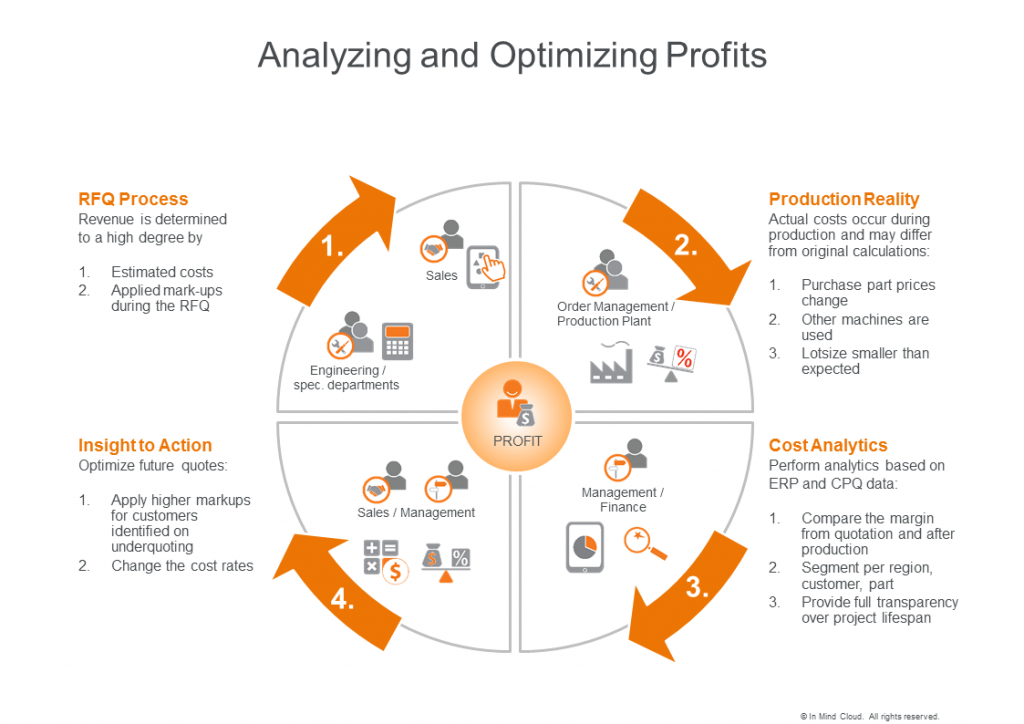Contract manufacturing (CM) industries are typically characterized by a combination of two critical factors; a) slim margins and b) mass productions with contracts running for several years. These characteristics are associated with significant risks that add up to the highly competitive global markets of today´s economy. If manufacturing businesses want to survive under these conditions, CEOs and CFOs need to make profitability management a top priority in their business operations.
But how can contract manufacturing businesses tackle this challenge? We believe we have the answer. Working and co-innovating with our customers in contract manufacturing and precision engineering, led to the development of an integrated process. The process connects relevant data from their Enterprise Resource Planning (ERP) and Configure-Price-Quote (CPQ) (part of a Digital Sales Platform) to feed analytics that result in detailed profitability insights. Supporting management and enhancing their decision-making processes with ad-hoc reports and analytics capabilities is key to success in profitability management.
The challenges of the contract manufacturing industry
Contract manufacturers are highly dependent on the contractor. After having submitted his quotation, the contract manufacturer's sell price is more or less fixed. Consequently, the maximum profitability that could be achieved for this order is fixed. It rarely turns out that the products can be produced cheaper than expected. However, the real costs incurred cannot be fully determined as the production often runs for several years. In this case, you have to account for several risks during this period.
Some of these business risks include:
- Production process changes
- Procurement of raw materials, components, and production facilities
- The uncertainty associated with outsourced production
- Market fluctuations
- Foreign exchange and interest rate volatility
- Global and technologically advanced competition
- Rapid innovations from emerging technology
For our customers, these circumstances are part of their business risks. The question is how they are mitigating these risks. Let us go back to the root of the process and see how price calculation works and how profit can be achieved.
In contract manufacturing, companies usually apply a "cost-plus approach" to determine the selling price. They are attempting to determine the costs of the parts that they are producing by adding up the material cost, additional purchase parts (e.g. screws), processes (machines), labor, and further subcontracting costs. On top of those costs and on different levels multiple markups are applied in order to achieve a margin.
You can read more about this topic from this source explaining the calculation scheme.
This approach is generally perceived as best practice for this industry and is widely used. Unfortunately, risk factors such as production volatility and further business changes have a negative effect on profitability. So how can you reduce the risks of decreased profitability?
Overcoming the challenges to increase profitability
In our experience gained from working with contract manufacturing businesses, we have developed the following approach to address this challenge:
- Connecting the quotation process with ERP data to gain transparency into the cost, revenue, and profit across the quotation-to-production lifespan
- Presenting real-time insights to the management on the profitability of the company, plant, or project
- Establishing unified financial reporting that focuses on one unified key metric
- Empowering better business decision-making—using facts derived from actual and past data—that maintains or increase profitability
The solution: Leveraging insights from ERP integration
Our approach to measure and improve profitability evolved into the strategy of leveraging insights from connecting the CPQ from our Digital Sales Platform, and ERP data via the following steps:
- Estimate costs and apply markups during the RFQ (Request for Proposal) process. Move accepted quotes including their new materials directly to the ERP system
- Measure actual costs reflected in ERP system
- Perform analytics comparing planned costs from the initial RFQ calculation to the actual costs in the ERP
- Optimize parameters for future quotes
1. Costing in CPQ processes
Firstly, the sales and project management team would assess the OEM's (Original Equipment Manufacturer) product requirements. An integrated CPQ system enables the team to create the BOM (Bill of Material) of the product, including the required materials and manufacturing processes.
Multiple departments are often involved in determining the right costing. For example, SCM (Supply Chain Management) would be responsible for capturing the costs of all purchasing materials, while engineering departments contribute their process knowledge. You can read more about that in my post about why a standard CRM doesn’t help contract manufacturing businesses.
2. Measure costs in your ERP
Once a quote is accepted, cost estimates need to move to the ERP system used for capturing actual costs. In most cases, new materials need to be created for a quote. This is a slow and highly manual process.
It is a huge advantage when your Digital Sales Platform can automate this task and create these materials in the ERP, together with its BOM (Bill of Material) and ERP routing of the machines. With this automation in place, the sales order containing the selling price and the estimated quantity of the product can be generated.
3. Perform analytics comparing planned costs with the actual costs
The planned costs from the quotation stage are already available in the Digital Sales Platform's CPQ. In addition, actual costs from ERP are delivered to the CPQ analytics tool. This step establishes a strong link between actual costs and planned costs.
Consequently, actual profit and planned profit can also be compared. Key values to be extracted are; actual sales quantity, actual costs, and actual selling price. In production planning, actual costs will almost always differ from the estimated ones. But the more important question is whether actual costs are higher or lower.
To find the answer, analytics can be performed to combine estimation data from CPQ and production data from ERP. This provides full transparency over the project's multi-year lifespan. Usually, there are multiple price points negotiated depending on the order quantity. That is why it is important to amortize fixed costs for setups in batches. Even then, profitability can change over the project duration due to multiple reasons like:
- Change in purchased part prices
- Machines not included in the quotation are used for production
- Lot size is smaller than expected
It is especially important to see if there are significant differences between quoted and actual costs for; segmented customers, regions or single projects. Analytics can also provide interesting findings when comparing profit over different periods of the production time span.
4. Optimize parameters for future quotes.
With these insights, we can now be aware of critical changes in profitability between quoted and actual projects. The advantage of this approach is a closed cycle with analytics at the last step that connects to sales processes in the first step. With both being executed in the CPQ system of a Digital Sales Platform.
Insights from the analytics can be used to improve the profitability of future quotes. It can also be used to analyze the differences in a BI (Business Intelligence) tool that is fed by the CPQ and ERP system. But in this case, it is a workaround that lacks an intelligent integration.
So now it is time to act on those differences you have discovered.
- Salespeople can be told to apply higher markups (this can be the default action) for specific projects with discrepancies
- The finance department can equalize mismatched rates or introduce a higher buffer
- Tightly control changes in quoted and ordered quantity in the contact
Discovering these differences can also point out customers that are more profitable than expected. This gives manufacturers the flexibility to offer additional discounts to close the deal in competitive situations.
Conclusion: One platform to tackle your challenges
Having a CPQ embedded in a Digital Sales Platform and leveraging all your ERP data in real-time helps all contract manufacturing companies to precisely estimate the costs of a multi-year deal and mitigate associated risks. Deep insights empower CEOs and CFOs to act on cost differences and learn from data from the past.
A CPQ from a powerful Digital Sales Platform has multiple advantages. First and foremost, it optimizes your sales process in terms of efficiency and accuracy. It can also connect sales data with production data from your ERP system—a feature that is increasingly a necessity when it comes to governing profitability and a competitive advantage in fiercely contest markets.
Keeping a contract manufacturing business running smoothly has never been an easy task. But with the help of digital technology, CEOs and business owners can now monitor the profitability of their business in real-time. This is an advantage that can help their businesses move ahead of the competition and ensure maximum customer retention.
Want to learn more about how a Digital Sales Platform can help your business manage profitability? Download our latest guide "Accelerate Manufacturing Sales" to find out how.

 Deutsch
Deutsch











